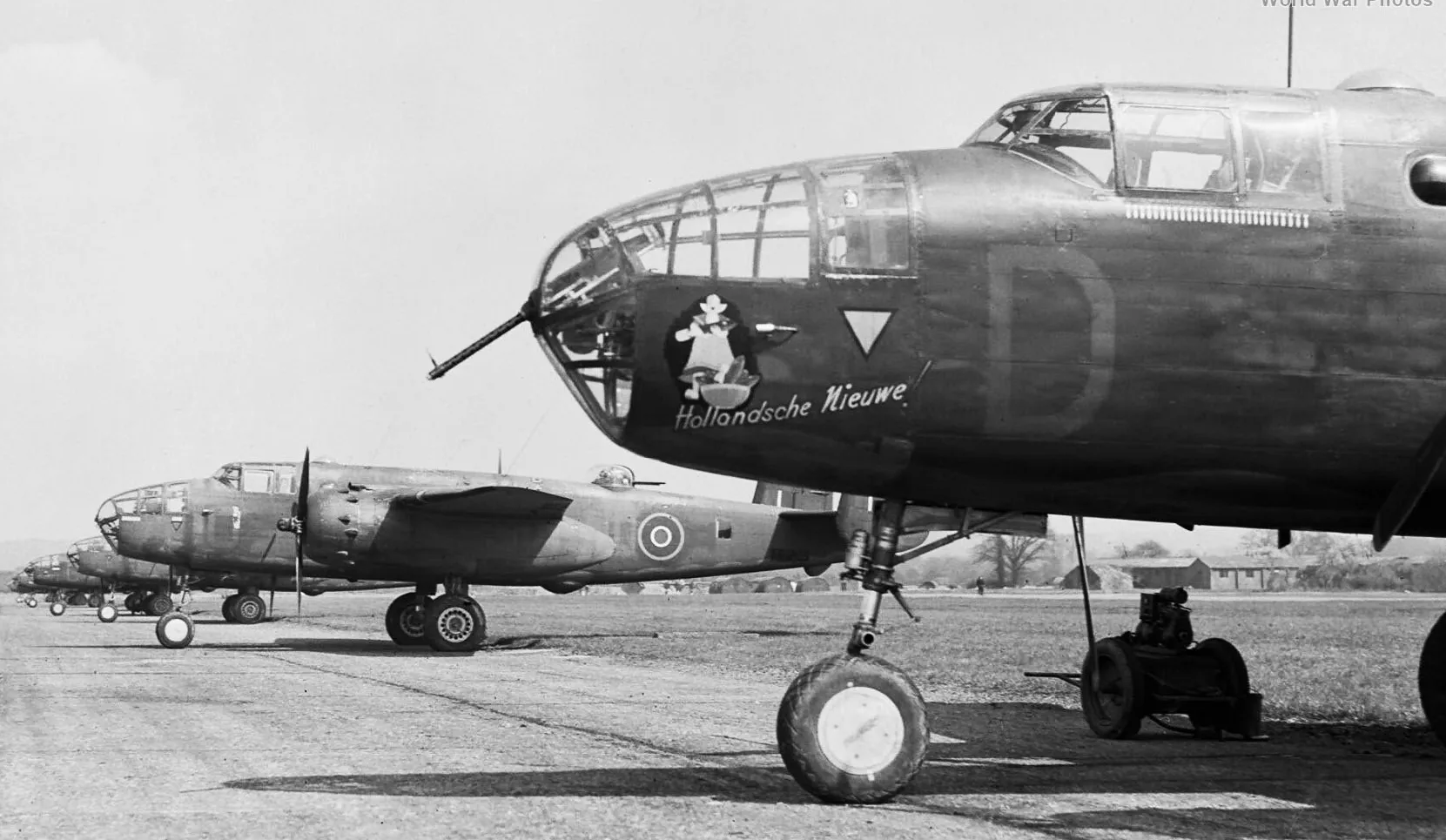Warplanes of the UK: North American Mitchell Mk. II
North American Mitchell Mk. II
The aim of this website is to locate, identify and document Warplanes from the Second World War preserved in the United Kingdom. Many contributors have assisted in the hunt for these aircraft to provide and update the data on this website. Photos are by the author unless otherwise credited. Any errors found here are by the author, and any additions, corrections or amendments to this list of Warplane Survivors of the Second World War in the United Kingdom would be most welcome and may be e-mailed to the author at hskaarup@rogers.com.
Warplanes of the Second World War preserved in the UK, including captured German and Japanese warplanes, are listed on separate pages on this web site.
Warplanes of the Second World War preserved in the United Kingdom by aircraft type, serial number, registration number and location:

(RAF Photo)
North American B-25 Mitchell Mk. III, RAF (Serial No. FV914), coded A, dropping 500-lb bmbs, ca 1944.
Royal Air Force
The Royal Air Force (RAF) was an early customer for the B-25 via Lend-Lease. The first Mitchells were given the service name Mitchell I by the RAF and were delivered in August 1941, to No. 111 Operational Training Unit based in the Bahamas. These bombers were used exclusively for training and familiarization and never became operational. The B-25Cs and Ds were designated Mitchell II. Altogether, 167 B-25Cs and 371 B-25Ds were delivered to the RAF. The RAF tested the cannon-armed G series but did not adopt the series nor the follow-on Hseries.
By the end of 1942, the RAF had taken delivery of 93 Mitchells, Marks I and II. Some served with squadrons of No. 2 Group RAF, the RAF's tactical medium-bomberforce, including No. 139 Wing RAF at RAF Dunsfold. The first RAF operation with the Mitchell II took place on 22 January 1943, when six aircraft from No. 180 Squadron RAF attacked oil installations at Ghent. After the invasion of Europe(by which point 2 Group was part of Second Tactical Air Force), all four Mitchell squadrons moved to bases in France and Belgium (Melsbroek) to support Allied ground forces. The British Mitchell squadrons were joined by No. 342 (Lorraine) Squadron of the French Air Force in April 1945.
As part of its move from Bomber Command, No 305 (Polish) Squadron flew Mitchell IIs from September to December 1943 before converting to the de HavillandMosquito. In addition to No. 2 Group, the B-25 was used by various second-line RAF units in the UK and abroad. In the Far East, No. 3 PRU, which consisted of Nos. 681 and 684 Squadrons, flew the Mitchell (primarily Mk. IIs) onphotographic reconnaissance sorties. (Wikipedia)

(IWM Photo, CH 20598)
North American Mitchell Mark IIs of No. 320 (Dutch) Squadron RAF lined up at Dunsfold, Surrey, during an inspection of No. 139 Wing by the Commander-in-Chief of the Allied Expeditionary Force, General Dwight D Eisenhower.

(IWM Photo, CH 11991)
North American Mitchell Mark II, (Serial No. FV929), coded VO-D’,of No. 98 Squadron RAF landing at Dunsfold, Surrey, after a daylight raid over northern France.


(IWM Photo, CH 20592)
North American Mitchell Mark II, (Serial No. FV98), coded VO-S, of No. 98 Squadron RAF based at Dunsfold, Surrey, approaches the English Channel south of Etaples while returning from a ‘Noball’ operation over northern France. Note the deployed ventral turret. "Noball" missions were missions against German missile sites.

(Library and Archives Canada Photo, MIKAN No. 4447477)
North American B-25 Mitchell Mk. II, RAF, taking off, ca 1944.

(RAF Photo)
North American B-25 Mitchell Mk. II, RAF, 1944.
.webp)
(RAF Photo)
North American B-25 Mitchell Mk. II, RAF, 1944. Y-VO.

(RAF Photo)
North American Mitchell Mk. II of No. 180 Squadron. EV-IW.

(RAF Photo)
North American Mitchell Mk. II of No. 180 Squadron. EV-IR.

(RAF Photo)
North American Mitchell Mk. II of No. 98 Squadron. V?-A.

(Library and Archives Canada Pjhoto, MIKAN No. 3650997)
North American B-25 Mitchell Mk. II, RAF, en route to the UK, ca 1941.

(Library and Archives Canada Photo, MIKAN No. 4447459)
North American B-25 Mitchell, being Bomb up, 22 Mar 1945.

(RAF Photo)
North American B-25 Mitchell, RAF No. 226 Sqn, coded MQ, T.

(IWM Photo, CH 12862)
North American Mitchell Mk. IIs of No. 98 Squadron RAF taxying along the perimeter track at Dunsfold, Surrey, for a morning raid on targets in northern France.

(RAF Photo)
North American B-25 Mitchell, RAF, being serviced, 1944.

(RAF Photo)
North American B-25 Mitchell, RAF.

(Alan Wilson Photo)
North American B-25J Mitchell (Serial No. 44-31171), Reg. No. N7614C, Imperial War Museum, Duxford, Cambridgeshire. It is painted in the markings of the 488 Bomb Squadron, USAAF, based in Corsica in 1944. This is a most appropriate scheme for a B-25, as it was in this unit that Joseph Heller flew as a bombardier. He was later to write famed novel ‘Catch 22’ based on his experiences in the unit. ‘34064’ was named 'LI'l Critter From The Moon' (which is on the port side) and was one of the aircraft in which it is known Heller flew. It was lost in January 1945 in a mid-air collision with sister aircraft 43-27657, while returning from a raid on San Michelle. The film of the movie involved some 17 airworthy Mitchells, most of which are still flying.

(Clemens Vasters Photo)

(Roland Turner Photo)
North American B-25J, ex-TB-25N Mitchell (Serial No. 44-29366), Reg. No. N9115Z, Royal Air Force Museum London, Hendon.
North American B-25J Mitchell (Serial No. 44-30861), "Bedsheet Bomber", rear fuselage and centre section moved to the Wings Aviation Museum near Balcombe, West Sussex on 3 May 2022, to be refurbished and returned to static display condition.





